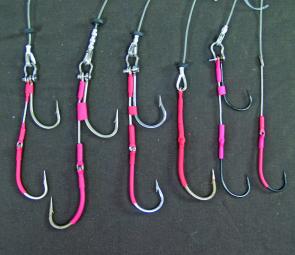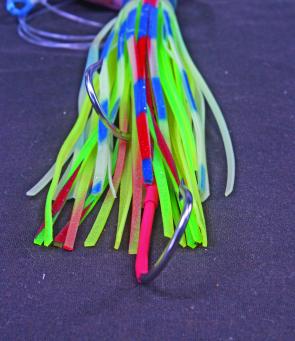Last month we discussed the components of a skirted lure rig and the equipment and materials required to make one at home. While the initial cost of getting everything together can seem quite high, it’s a budget option in the long run that allows a lot more flexibility in your rigging. Some lures will benefit greatly from custom rigging as it allows them to exhibit the natural action intended by their maker. As a result of quality custom rigging, you will achieve more strikes and a greater degree of solid hook-ups. This month we will look at a few of the factors that can affect your choice of hook rigs.
There are a lot of differing views around about what’s the most successful rig to put in any lure. As they say, opinions are like bums, everyone’s got one. Twin hooks, single hook, 30, 45, 60 or 90 degree offsets, stiff rigs, loose rigs are a few of the rigging quandaries facing those new to rigging and using skirted lures.
Which hook pattern to choose for maximum hook-up potential is a topic that is hotly debated when serious anglers get together. There are myriad factors other than the hook rig that can affect how a lure performs in the water. These can include boat speed, sea conditions, currents, leader thickness, type of species hitting the lure and the angle that each individual fish approaches from. The best you can hope to achieve in your rigging choice is to put a rig in the lure that doesn’t hinder its performance and provides good hook exposure to attacking fish. Everyone has their own opinion, but in reality there is often no definitive or correct rig. There are however a few basic rules which need to be followed when deciding on how to rig a particular lure.
Hooks must be strong enough to avoid distortion, whilst still being thin enough for easy penetration on your chosen line class. The rigged lure must be able to maintain its natural action in the water and not be hindered by bulky hooks or thick leader. Another important factor with hooks is that they must be razor sharp every time the lure is put in the water, not just the first time. While you may need to try various combinations with each individual lure and make up your own mind in regard to their suitability over a period of time, I will give you a little bit of food for thought and a few other facts and theories for you to ponder.
Single hook rigs can be used in any lure and many anglers believe that they are the best rigging option for maintaining a lure’s natural action. There is a lot of debate and even a push from some anglers in the USA to make single hooks the only rigging option under IGFA tournament rules. The safety aspect is a good argument for the sole use of single hook rigs, as there is no second hook swinging freely when a fish is gaffed, tagged or being unhooked to cause injury. Removing a single hook from a fish is quicker, easier and safer, resulting in the fish being released in better condition. Once set, a single hook is a lot less likely to come out, especially when hooks such as the southern and tuna style (which have a slightly turned in point) are used. The elimination of a leading hook in the rig will also allow the lure to swim more freely with a lighter rig in it. This also creates a more natural action from the lure, thereby enticing more strikes. More strikes produce more hook-ups and eventually more captures.
Twin hook rigs are ideal for straight runners and lures that don’t have vibrant head actions or dense skirting materials. Some of these lures will also swim well with twin hook rigs in them, however if tangling occurs between the skirt and the leading hook, then you would be best to switch to a single hook rig. One argument for twin hook rigs is that two points have a greater potential to hook a striking fish than one point. Conversely, some anglers believe that it is easier for a fish to throw a twin hook rig than a single as they can work one hook against the other with a chewing action. Unfortunately, with twin hook rigs, there is always the possibility a fish that is broken off may not survive. If a fish were to get one hook of the rig in the top jaw and the second hook in the bottom jaw, thereby becoming jaw locked, it would eventually starve to death.
There are a lot of views for and against both single and twin hook rigs and everyone is entitled to their opinion. You are best to try a combination of both in different lures until you can form your own views. There are so many rigging options available for the numerous lure and skirt combinations on the market for both single and twin hook rigs. It is a case of trying different rigging options until you find one that suits the lure in question.
The basic shackle rig has become a popular rigging option due to the flexibility it offers. It provides the ability to easily change hooks or entire rigs from one lure to the other. This is a good option when an angler has several lures of a similar size and wishes to use high quality stainless steel hooks in all of them when they are in use.
As high quality hooks can be quite expensive (often more than $10 each), plus a few dollars for a shackle, the angler may only put leaders with thimbled loops in every lure. Then it is just a case of alternating the hook rig between different lures by undoing the bow shackle and swapping the hook rig over from the retired lure to the one being sent out for duty. The angler may have five or six hook rigs and alternate them between different lures that have similar lengths between the back of the head and the bottom of the skirt. Even lures with slightly longer skirt lengths can be included in this hook rotation system if you space the distance between the thimbled loop and the back of the head with a few beads so that the rig is still long enough for the lure. This system can be utilised with single hook rigs as well as twin hook rigs.
Some anglers like to store their hook rigs separate to their lures to avoid tangles and decrease the possibility of corrosion to the hooks. After each outing the few sets of hooks are removed from the skirted lures, cleaned and stored separately to the lures. The angler then hangs his lure roll, hoses it out and leaves it to air. Once dry it is rolled back up and stowed away without fear that the hooks may corrode and stain the skirts of the lures. Even high quality stainless steel hooks can suffer the effects of prolonged exposure to salt, although the rusting may only be superficial surface corrosion. Duratin coated, some Teflon coated and most chemically sharpened hooks require a lot of care to keep them in good nick.
Shackles are around $3 to $5 each and as a result many anglers just choose to keep their rigs simple by attaching the hook or hooks straight to the leader. This is fine also but ensure you regularly check for abrasion where the leader material goes through the hook eye and wire of the trailing hook.
Next month we will look at a few more rigging options including hook positioning and offsets, plus some nifty ways to promote the performance, hooking potential and action of your lures.
Reads: 762
There are a lot of different rigging options available and a lot of debate about which rig produces the best hook-up to strike rate

With twin hook shackle rigs there is a lot of debate about what degree of offset between the hooks produces the best hook-up rate.

Shackles allow easy changing of hook rigs from one lure to another.




